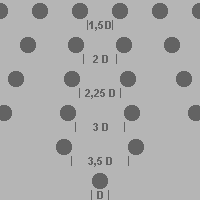Intercolumniation on:
[Wikipedia]
[Google]
[Amazon]
 In
In
 In
In architecture
Architecture is the art and technique of designing and building, as distinguished from the skills associated with construction. It is both the process and the product of sketching, conceiving, planning, designing, and constructing buildings ...
, intercolumniation is the proportional
Proportionality, proportion or proportional may refer to:
Mathematics
* Proportionality (mathematics), the property of two variables being in a multiplicative relation to a constant
* Ratio, of one quantity to another, especially of a part compare ...
spacing between column
A column or pillar in architecture and structural engineering is a structural element that transmits, through compression, the weight of the structure above to other structural elements below. In other words, a column is a compression member ...
s in a colonnade
In classical architecture, a colonnade is a long sequence of columns joined by their entablature, often free-standing, or part of a building. Paired or multiple pairs of columns are normally employed in a colonnade which can be straight or curv ...
, often expressed as a multiple of the column diameter as measured at the bottom of the shaft. In Classical, Renaissance
The Renaissance ( , ) , from , with the same meanings. is a period in European history marking the transition from the Middle Ages to modernity and covering the 15th and 16th centuries, characterized by an effort to revive and surpass id ...
, and Baroque architecture
Baroque architecture is a highly decorative and theatrical style which appeared in Italy in the early 17th century and gradually spread across Europe. It was originally introduced by the Catholic Church, particularly by the Jesuits, as a means t ...
, intercolumniation was determined by a system described by the first-century BC Roman
Roman or Romans most often refers to:
*Rome, the capital city of Italy
*Ancient Rome, Roman civilization from 8th century BC to 5th century AD
* Roman people, the people of ancient Rome
*'' Epistle to the Romans'', shortened to ''Romans'', a lett ...
architect Vitruvius
Vitruvius (; c. 80–70 BC – after c. 15 BC) was a Roman architect and engineer during the 1st century BC, known for his multi-volume work entitled '' De architectura''. He originated the idea that all buildings should have three attribut ...
(Vitruvius, ''De architectura
(''On architecture'', published as ''Ten Books on Architecture'') is a treatise on architecture written by the Roman architect and military engineer Marcus Vitruvius Pollio and dedicated to his patron, the emperor Caesar Augustus, as a guide f ...
'', iii.3.3-10). Vitruvius named five systems of intercolumniation (Pycnostyle, Systyle, Eustyle, Diastyle, and Araeostyle), and warned that when columns are placed three column-diameters or more apart, stone architraves break. According to Vitruvius, the Hellenistic architect Hermogenes (ca. 200 BC) formulated these proportions ("''symmetriae''") and perfected the Eustyle arrangement, which has an enlarged bay
A bay is a recessed, coastal body of water that directly connects to a larger main body of water, such as an ocean, a lake, or another bay. A large bay is usually called a Gulf (geography), gulf, sea, sound (geography), sound, or bight (geogra ...
in the center of the façade
A façade () (also written facade) is generally the front part or exterior of a building. It is a loan word from the French (), which means 'frontage' or ' face'.
In architecture, the façade of a building is often the most important aspect ...
.
Standard intercolumniations
The standard intercolumniations are: ; Pycnostyle : One and a half diameters ; Systyle : Two diameters ; Eustyle : Two and a quarter diameters (and three diameters between middle columns front and rear); considered by Vitruvius to be the best proportion. Vitruvius, ''De architectura'', iii.3.6. ; Diastyle : Three diameters ; Araeostyle : Four or more diameters, requiring a wooden architrave rather than one of stone ; Araeosystyle : Alternating araeostyle and systyle Vitruvius's definitions seem to apply only to examples with which he was acquainted in Rome, or to Greek temples described by authors he had studied. In the earlier Doric temples the intercolumniation is sometimes less than one diameter, and it increases gradually as the style developed; thus in theParthenon
The Parthenon (; grc, Παρθενών, , ; ell, Παρθενώνας, , ) is a former temple on the Athenian Acropolis, Greece, that was dedicated to the goddess Athena during the fifth century BC. Its decorative sculptures are conside ...
it is in the Temple of Diana Propylaea at Eleusis, and in the portico at Delos, 2. The intercolumniations of the columns of the Ionic Order
The Ionic order is one of the three canonic orders of classical architecture, the other two being the Doric and the Corinthian. There are two lesser orders: the Tuscan (a plainer Doric), and the rich variant of Corinthian called the composi ...
are greater, averaging 2 diameters, but then the relative proportion of height to diameter in the column has to be taken into account, as also the width of the peristyle. Thus in the temple of Apollo Branchidae, where the columns are slender and over 10 diameters in height, the intercolumniation is notwithstanding its late date, and in the Temple of Apollo Smintheus in Asia Minor, in which the peristyle is pseudodipteral, or double width, the intercolumniation is just over 1. Temples of the Corinthian Order follow the proportions of those of the Ionic Order.
See also
* List of architecture topics * Architectural glossaryReferences
Colonnades {{architecturalelement-stub